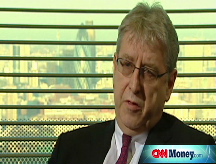Treasurys rise on AIG, economy
Prices for ultra-safe U.S. government bonds climb as stock prices fall to historic lows following AIG's monumental fourth-quarter loss.
NEW YORK (CNNMoney.com) -- Bond prices rose Monday as stocks buckled in response to a massive quarterly loss by insurance giant AIG and ongoing concerns about the economy.
New York-based American International Group (AIG, Fortune 500) said it lost nearly $62 billion in the fourth quarter - the largest quarterly loss in U.S. history - on strained credit markets and restructuring charges. All told, AIG lost $99 billion in 2008.
The loss shook an already fragile stock market, sending the Dow below 6,800 for the first time in nearly 12 years, while the S&P 500 hovered near its lowest level since 1996.
"Every time the stock market goes down 100 points you're going to get a bond effect," said Kevin Giddis, managing director of fixed income at Morgan Keegan.
U.S. Treasurys are viewed as one of the most secure assets available. As a result, prices for Treasurys often climb when stock prices fall as demand for safety outweighs investors' appetite for risk.
Stock prices were also lower overseas. European indexes were down 3.8% to 5.6%, and Tokyo's Nikkei index lost 3.8%.
At the same time, the Treasury Department announced plans to invest another $30 billion in AIG to help stabilize the tottering company. It also modified the terms of its bailout of AIG for the third time.
AIG continues to face "significant challenges" and the company poses a "systemic risk" to the fragile financial system, according to he Treasury Department.
"The additional resources will help stabilize the company, and in doing so help to stabilize the financial system," the department said in its announcement.
Economy: In addition to the AIG news, the market also digested a host of readings on the economy.
The Commerce Department reported that both consumer spending and income unexpectedly rose in January. But economists do not expect the trend to last.
Construction spending, however, sank to its lowest level in more than four years during January, the government said in a separate report.
An index of manufacturing activity also rose unexpectedly. The Institute for Supply Management's manufacturing index edged up to 35.8 from last month 35.6 in January, but continued to indicate a recession. Economists were expecting a reading of 34, according to consensus estimates from Briefing.com.
The index's measure of prices paid by manufacturers declined, which eased inflation fears and helped boost prices for longer-term Treasurys, according to Giddis.
Underscoring all of Monday's economic news was last week's report on fourth-quarter gross domestic product. The government reported Friday that GDP, which measures the output of goods and services made in the United States, fell at a 6.2% annual rate, the biggest fall in GDP since the first quarter of 1982.
Treasury prices: The benchmark 10-year note was up 1-8/32 to 99, and its yield fell to 2.87% from 3.02% late Friday.
The 30-year long bond rose 1-22/32 to 97-31/32 and yielded 3.50%.
The 2-year note advanced 6/32 to 100 with a yield of 0.89%.
Lending rates: The 3-month Libor rate rose to 1.27% from 1.26% Friday, according to data on Bloomberg.com. The overnight Libor rate fell to 0.31% from 0.36%.
Libor, the London Interbank Offered Rate, is a daily average of rates that 16 different banks charge each other to lend money in London.
One credit market gauge showed less confidence in the credit market, and one was unchanged. The "TED" spread widened to 1.03 percentage point from 1.01 percentage point Friday. The wider the TED spread, the less willing investors are to take risks.
The Libor-OIS spread was unchanged from late Friday at 1.01 percentage point. The wider the spread, the less cash is available for lending.
Talkback: Are you living on your unemployment check? How are you making ends meet? What bills are you paying - and which ones are sliding? E-mail your story to realstories@cnnmoney.com and you could be part of an upcoming article. ![]()



